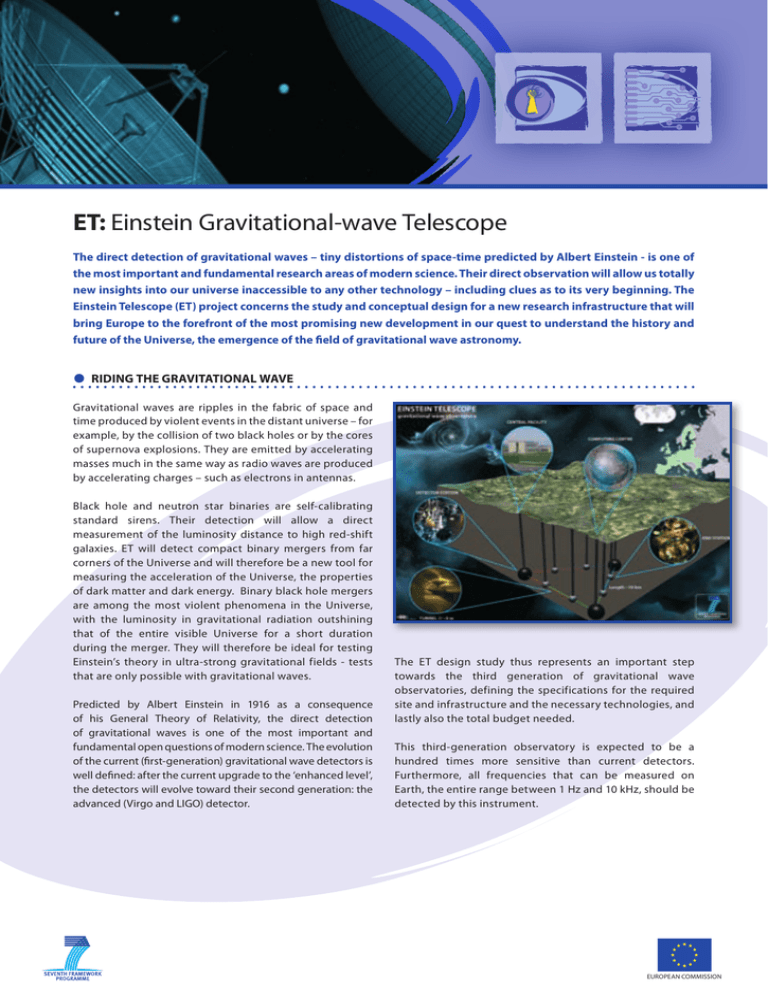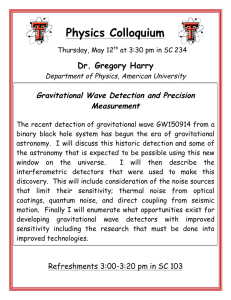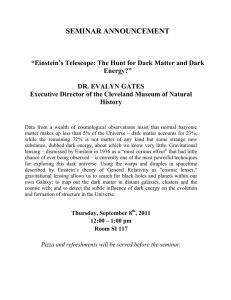ET: Einstein Gravitational
advertisement

ET: Einstein Gravitational-wave Telescope The direct detection of gravitational waves – tiny distortions of space-time predicted by Albert Einstein - is one of the most important and fundamental research areas of modern science. Their direct observation will allow us totally new insights into our universe inaccessible to any other technology – including clues as to its very beginning. The Einstein Telescope (ET) project concerns the study and conceptual design for a new research infrastructure that will bring Europe to the forefront of the most promising new development in our quest to understand the history and future of the Universe, the emergence of the field of gravitational wave astronomy. • Riding the gravitational wave Gravitational waves are ripples in the fabric of space and time produced by violent events in the distant universe – for example, by the collision of two black holes or by the cores of supernova explosions. They are emitted by accelerating masses much in the same way as radio waves are produced by accelerating charges – such as electrons in antennas. Black hole and neutron star binaries are self-calibrating standard sirens. Their detection will allow a direct measurement of the luminosity distance to high red-shift galaxies. ET will detect compact binary mergers from far corners of the Universe and will therefore be a new tool for measuring the acceleration of the Universe, the properties of dark matter and dark energy. Binary black hole mergers are among the most violent phenomena in the Universe, with the luminosity in gravitational radiation outshining that of the entire visible Universe for a short duration during the merger. They will therefore be ideal for testing Einstein’s theory in ultra-strong gravitational fields - tests that are only possible with gravitational waves. Predicted by Albert Einstein in 1916 as a consequence of his General Theory of Relativity, the direct detection of gravitational waves is one of the most important and fundamental open questions of modern science. The evolution of the current (first-generation) gravitational wave detectors is well defined: after the current upgrade to the ‘enhanced level’, the detectors will evolve toward their second generation: the advanced (Virgo and LIGO) detector. The ET design study thus represents an important step towards the third generation of gravitational wave observatories, defining the specifications for the required site and infrastructure and the necessary technologies, and lastly also the total budget needed. This third-generation observatory is expected to be a hundred times more sensitive than current detectors. Furthermore, all frequencies that can be measured on Earth, the entire range between 1 Hz and 10 kHz, should be detected by this instrument. EUROPEAN COMMISSION ET: Einstein Gravitational-wave Telescope • An eye on the past Observation of gravitational waves would have far-reaching consequences, aside from verifying the General Theory of Relativity: it would become possible to cast an eye on the ‘early childhood’ of our universe for the first time. Until now, observation of the sky is limited to the electromagnetic spectrum (e.g., radio and X-ray telescopes and astronomy in visible light) and observation of cosmic rays and neutrinos. The information thus available to us can reach us from the past only from a time at least 380 000 years after the Big Bang. Epochs dating back further have thus far remained hidden, as the universe became transparent for electromagnetic radiation only at that time. The various theories on the early universe have therefore remained unverified experimentally. The direct measurement of gravitational waves may allow ‘listening’ back as far as the very first trillionth of a second following the Big Bang. This would give us totally new information about our universe: with gravitational wave astronomy, totally new areas of science will become accessible. The main objective of the ET design study is to realise the conceptual design of a third-generation gravitational wave detector, with the specifications of the site and infrastructure characteristics and the description of the requirements of the detector main components. Project acronym: ET Funding scheme: Design Studies (DS) Gravitational wave research is a global effort because the full information about many gravitational wave sources can only be obtained with several interferometers working simultaneously in different places. Therefore the US, GermanBritish, Italian-French, and Dutch scientific communities have been working together closely for a long time. They share technology development, numerical relativity methods and data analysis methods and tools. The joint European project ET, already included into the roadmaps of the worldwide gravitational wave scientific community, will help to further improve this worldwide collaboration. Coordinator: Jacques Colas, et-ds@ego-gw.it Project webpage: www.et-gw.eu EU financial contribution: €3 million EU project officer: Elena Righi-Steele Duration: 38 months Start date: 5 May 2008 Completion date: 4 july 2011 Partners: European Gravitational Observatory (IT) Istituto Nazionale di Fisica Nucleare (IT) Max-Planck-Gesellschaft zur Foerderung der Wissenschaften e.V., acting through Max- Planck-Institut fuer Gravitationsphysik (DE) Centre National de la Recherche Scientifique (FR) University of Birmingham (UK) University of Glasgow (UK) Vrije Universiteit Amsterdam, Nikhef (NL) Cardiff University (UK) © European Communities, November 2009 Reproduction is authorised provided the source is acknowledged EUROPEAN COMMISSION




